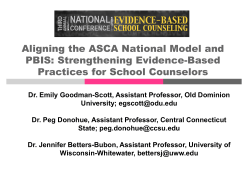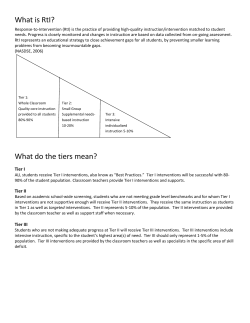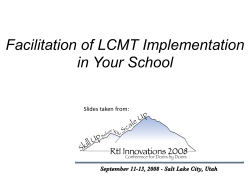
CT Core Standards: Implications for SPED/SRBI/EL
CT Core Standards: Implications for SPED/SRBI/EL CCSS for SRBI Math Tier 2 and Tier 3 Students Goals for this session: Participants will…. • Review RTI model • Experience what it’s like to be a student struggling with math • Learn the components of an SRBI Math program • Review recommendations from the What Works Clearinghouse • Learn of resources to aid in your SRBI efforts Essential Components of SRBI/RTI Basic Review of SBRI Model: www.learnnc.org Diagram by Daniel Lunk Think of that student: • Who thinks she’s a dummy because she just doesn’t get it when everyone else seems to • Who acts out because it’s easier than showing he doesn’t understand • Who copies everything down and looks like he knows what he’s doing, but cannot tell you what it means • Who’s frustrated because she thought she knew the rules but the rules keep changing Excerpts from: Hidden Ambitions by Ronald F. Ferguson, Ph.D. There are things I’d tell my teachers If I only had a chance. Like the reasons I so often Seem to drift off in a trance. Since I act like I don’t care About my low grades and performance, No teacher wants to work with me They all express reluctance. What they cannot see by looking Is that I’m quite insecure. Even when I’m acting macho What I’m feeling is unsure. So I wish I had the courage When I’m lost and feeling frightened To let teachers know I want some help To have my prospects brighten. My classmates think I’m smart But just refuse to buckle down, That somehow I like my status As the classroom’s premier clown. If only there was some way I could make a true confession That I’m not the clown I seem I want to master all my lessons. Ronald F. Ferguson, October 2013 Let’s walk a mile in their shoes… • 23 + 12 = ? • 23 + 12 ≠ 35? What? Why not????? • 23 +12 = 101 What??? The magic of Base 4: Now you try it! • 23 + 32 = ? in Base 4 • 143 + 41 = ? in base 5 How did you feel while doing these “simple” math problems? Who should always be at the center of our SRBI planning and decision making? A 4-Tiered Intervention Model Tier 1: Benchmark Level • Who: all students – Will be successful for approx. 80% of students • What: high quality, empirically supported curriculum and instruction • When: regularly scheduled classroom instruction • How assessed: progress is monitored at minimum three times a year – Benchmark screening during the Fall, Winter and Spring Tier 2: Supplemental Level • Who: students not making adequate progress in the Tier 1 core curriculum – – 10% - 15% of students – Small group instruction • What: research-based instruction and strategies that are matched to student need and focused on core competencies that support, enhance, or supplement Tier 1 instruction • When: in addition to core instruction, several times a week • How assessed: on-going (1-2 times a month) progress monitoring to measure student response to intervention and to guide decision making Tier 3: Intensive Level • Who: students not making adequate progress in the Tier 1 core and Tier 2 curriculum – – Approx. 5% of students – Individual and small group instruction • What: research-based intense intervention and strategies that are matched to individual student need and progress and focused on core competencies • When: in addition to core instruction, every day • How assessed: on-going (1-2 times per week) progress monitoring to measure student response to intervention and to guide decision making Tier 4: Specially Designed Instruction Level • Who: students not able to make progress in the Tiers 1, Tier 2, or Tier 3 – Approx. 1% of students; PPT decision – Individualized instruction • What: specialized programs, methodologies, or instructional delivery of focused, targeted research-based instruction and strategies that are matched to individual student need and progress and focused on core competencies • When: every day in place of Tiers 1-3 • How assessed: daily progress monitoring to measure student response to intervention and to guide decision making New Study Shows Benefits of Visual, Game-Based Math: EdWeek 12/08/14 http://blogs.edweek.org/edweek/on_innovation/2014/12/new_study_shows_benefits_of_visual_gam e-based_math.html Other Programs Helping to Individualize: https://www.tenmarks.com/ Grades K-8 and HS Intervention http://www.dreambox.com/mathintervention Grades 1 – Algebra 2 and Geometry http://blogs.edweek.org/edweek/on_inn ovation/2014/12/new_study_shows_ben efits_of_visual_game-based_math.html And what about students with an IEP? http://coe.lehigh.edu/content/what-rti Progress Check! Let’s do a Kahoot! Join at: kahoot.it https://play.kahoot.it/#/?quizId=e5536744-ba934e94-8cec-6d96b6240196 My “Go-to” Resource for Math SRBI: http://ies.ed.gov/ncee/wWc/ pdf/practice_guides/rti_math _pg_042109.pdf Each recommendation includes: 1. Brief Summary 2. How to carry out the recommendation 3. Potential roadblocks and solutions Recommendation 2: • Instructional materials should focus intensely on in-depth treatment of: – Grades K-3: Number sense, place value of whole numbers and operations with whole numbers – In Gr.4-8: use an understanding of whole numbers to build conceptual framework and work with rational numbers, which are critical for future success in math • Cover fewer topics in more depth and with coherence • Intervention curriculum should not be over-simplified Is my SRBI program aligned to the core curriculum? • Alignment with the core curriculum is not as critical as ensuring that instruction builds students’ foundational proficiencies. • Tier 2 and tier 3 instruction focuses on foundational and often prerequisite skills that are determined by the students’ rate of progress. Recommendation 3: • Instruction should be explicit and systematic: – Instruction should gradually build proficiency by introducing concepts in a logical order and providing students with numerous applications of each concept and skill • CCSS Shift: Rigor = conceptual understanding, procedural skill and fluency, and application – Explicit instruction ensures that students possess the foundational skills and conceptual knowledge necessary for understanding their grade-level mathematics Explicit Instruction includes: • Teacher demonstration of proficient problem solving with sufficient models • Verbalization of the thought processes and the reasons behind math procedures, formulas, and problem-solving methods – Teachers should be knowledgeable enough to anticipate and address misconceptions – Include numerous clear models of easy and difficult problems, with accompanying teacher think-alouds Explicit Instruction includes: • Guided, scaffolded, extensive practice – Teacher should ask students to communicate the strategies they are using to complete each step of the process and provide reasons for their decisions • CCSS Math Practice #3: “Construct viable arguments and critique the reasoning of others.” • Teachers provide immediate, specific, actionable corrective feedback with opportunities to correct errors (with guidance, as needed) • Frequent, cumulative review Sal Khan’s Words of Wisdom The Learning Myth: Why I’ll Never Tell My Son He’s Smart https://www.khanacademy.org/about/blog/post /95208400815/the-learning-myth-why-ill-nevertell-my-son-hes Recommendation 4: • Interventions should include instruction on solving word problems that is based on common underlying structures – Visual representations can be effective for teaching students how to categorize problems based on their structure and determine a solution method appropriate for the underlying structure Math Story Problem Types: http://www.teachertipster.com/ CGI_problem_types.pdf http://ies.ed.gov/ncee/ wwc/pdf/practice_guides/ mps_pg_052212.pdf http://ies.ed.gov/ncee/wwc/PracticeGuide.aspx?sid=16 Recommendation 5: • Intervention materials should include opportunities for students to work with visual representations of mathematical ideas • Interventionists should be proficient in the use of visual representations of mathematical ideas Recommendation 5: • The ability to express mathematical ideas using visual representations and to convert visual representations into symbols is critical for success in mathematics – Visual representations such as number lines, number bonds, strip diagrams/bar models, concrete drawings, and other forms of pictorial representations help scaffold learning and pave the way for understanding the abstract version of the representation – Interventionists should explicitly link visual representations with the standard symbolic representations: CRA progression The CRA Progression Research indicates that using manipulatives is especially useful for teaching low achievers, students with learning disabilities, and English language learners. (Marsh and Cooke, 1996; Ruzic and O’Connell, 2001) Interventionists should allow students to continue to use manipulatives to demonstrate their understanding in the representational and abstract stages, if needed. https://www.hand2mind.com/pdf/learning_place/research_math_manips.pdf When it’s Over by Ron F. Ferguson, Ph.D. The lesson ain’t over ‘til the skinny kid smiles and signals that he understands. April, 2000 Ronald F. Ferguson, Faculty Co-Chair and Director, Achievement Gap Initiative at Harvard University and Founder, the Tripod Project for School Improvement Recommendation 6: • Interventions at all grade levels should devote about 10 minutes in each session to building fluent retrieval of basic arithmetic facts. – Quick retrieval of basic math fats is critical for success in mathematics – Weak ability to fluently retrieve math facts impedes later understanding of rational number concepts Recommendation 6: – The goal is quick retrieval of facts using the digits 0 to 9 without any access to pencil and paper or manipulatives • Fact families are an efficient way to learn – In grades 2-8, also include instruction on how to use the commutative, associative, and distributive properties to derive more complex facts in their heads NCTM Wisdom: February, 2104 Growth Mindset! CCSS Math Practice #1: Make sense of problems and persevere in solving them. Resources: What Works Clearinghouse http://ies.ed.gov/ncee/wwc/default.aspx Resources: RTI Action Network http://www.rtinetwork.org/learn/what Resources: National Center on Intensive Intervention http://www.intensiveintervention.org/resources/tools-charts Resources: National Center on Intensive Intervention - Tools Chart RTI Implementer Series Self-paced Learning Modules http://www.rti4success.org/rti-implementer-series-self-paced-learning-modules Common Core State Standards http://teacher.scholastic.com/products/math180/assets/CommonCoreProgressAlgebra.pdf SRBI Planning Tool: Last year: Focus was on building strong foundational skills to support Tier 1 content SRBI Planning Tool: SRBI Planning Tool: This year: Focus is on remediating Tier 1 content from the prior marking period Fact Fluency Program: http://teacher.scholastic.com/math-fact-fluency/fastt-math-next-generation/ Renaissance Learning: Accelerated Math http://www.renaissance.com/products/accelerated-math Marilyn Burns’ “Do the Math” program http://teacher.scholastic.com/products/dothemath/dtmn_structure.htm Engage NY.org Learn Zillion https://learnzillion.com/resources/17132 Persist by Ron F. Ferguson, Ph.D. There is no greater frustration than to be stubbornly misunderstood by a child who is afraid that she can’t learn. And there is no greater elation than when the light of understanding burns away the fear and makes her smile return. April, 2000 Contact information: Email: cfreeman@windsorct.org Twitter : @CayFreeman
© Copyright 2025











